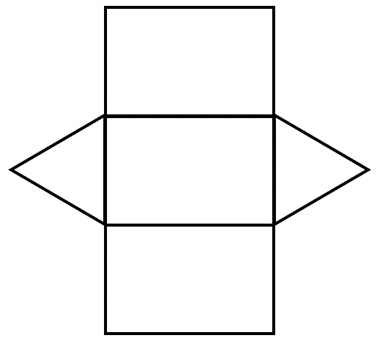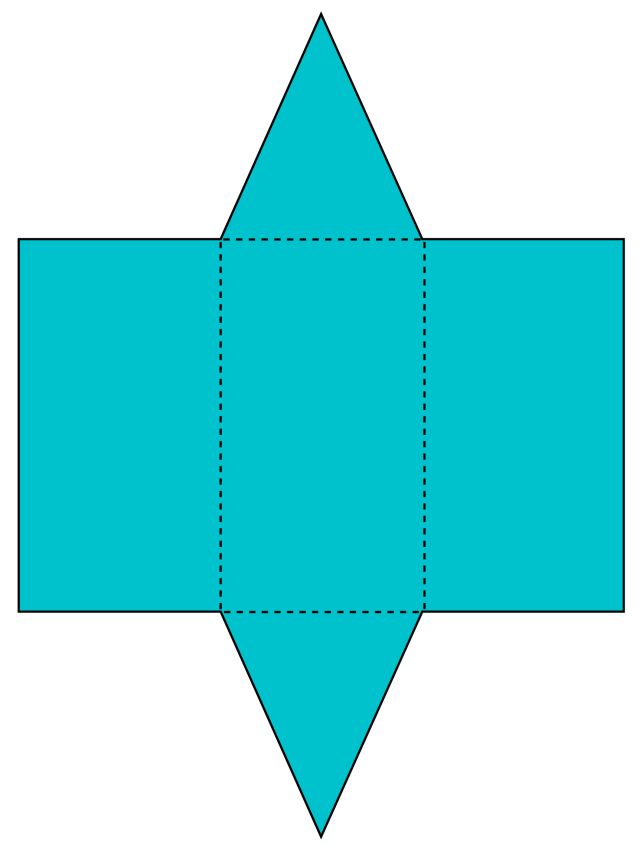
So we’ll repeat that process again for the second triangle. One-half times eight times six, well one-half times eight is four, and four times six is 24. So we need to take six times 15 for the pink rectangle, eight times 15 for the green rectangle, and 10 times 15 for the blue rectangle. Now we have the rectangles, and the area of a rectangle is length times width. So we can either take that and multiply by two or write it twice since we have two triangles. And it’s important that we know that that’s a right angle in the corner of the triangle, because that let’s us know that the six is indeed perpendicular. So for the two rectangles, we have one-half times their base of eight times their perpendicular height, which is six. The area of a triangle is one-half times the base times the height. So if we find the area of each of these shapes and we add them together, we will have the surface area. So here we’ve drawn the net of the shape. We have the bottom rectangle, and keep in mind that these are not to scale, and then lastly the blue rectangle. So we have these two triangles, which are our bases we have the pink rectangle, found back here and we have this length as 15, because it matches this one. So our hint tells us to draw the net of this shape, which would be all of the faces laying flat so we can easily see them. So if we would like the surface area of this shape, we need to add the area of all of the faces together.

That’s what makes up a prism: the two bases and then the rest are rectangles.

And it’s a prism because the rest of the faces or the sides is what we can call them are rectangles. The bases, the parallel faces, are triangles. So we have- that this is a triangular prism.

Hint: you can draw the net of the shape to help you. All the other versions may be calculated with our triangular prism calculator.Find the surface area of this triangular prism. The only option when you can't calculate triangular prism volume is having given triangle base and its height (do you know why? Think about it for a moment). Using law of sines, we can find the two sides of triangular base:Īrea = (length * (a + a * (sin(angle1) / sin(angle1+angle2)) + a * (sin(angle2) / sin(angle1+angle2)))) + a * ((a * sin(angle1)) / sin(angle1 + angle2)) * sin(angle2) Triangular base: given two angles and a side between them (ASA) Using law of cosines, we can find the third triangle side:Īrea = length * (a + b + √( b² + a² - (2 * b * a * cos(angle)))) + a * b * sin(angle) Triangular base: given two sides and the angle between them (SAS) However, we don't always have the three sides given. area = length * (a + b + c) + (2 * base_area) = length * base_perimeter + (2 * base_area).If you want to calculate the surface area of the solid, the most well-known formula is the one given three sides of the triangular base : You can calculate that using trigonometry: Length * Triangular base area given two angles and a side between them (ASA) You can calculate area of a triangle easily from trigonometry: Length * Triangular base area given two sides and the angle between them (SAS) If you know the lengths of all sides, use the Heron's formula to find the area of triangular base: Length * Triangular base area given three sides (SSS) It's this well-known formula mentioned before: Length * Triangular base area given triangle base and height Our triangular prism calculator has all of them implemented, isn't it awesome?

A general formula is volume = length * base_area the one parameter you always need to have given is the prism length, and there are four ways to calculate the base - triangle area. In the triangular prism calculator you can easily find out the volume of that solid.


 0 kommentar(er)
0 kommentar(er)
